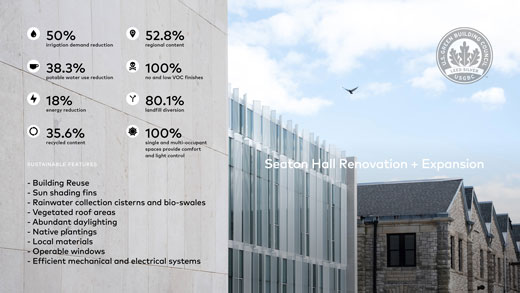February 9, 2021
Seaton, Regnier halls attract design students as future stewards of the environment as APDesign experiences enrollment growth

Seaton and Regnier halls, home to the College of Architecture, Planning & Design, or APDesign, at Kansas State University, set a significant example of sustainability in action for design students as future stewards of the environment. With the renovation of the LEED Silver-certified Seaton Hall and Regnier Hall, reflecting the college's pedagogical goals and stature among national design programs, APDesign has experienced a steady surge of student enrollment and retention rates amid the challenges experienced by colleges and universities across the U.S. in the midst of the COVID-19 pandemic.
The transformation of the APDesign facility encompassed a comprehensive renovation of the college's existing facilities in the historic buildings of Seaton East, built in 1908, and Mechanics Hall, built in 1874, now Regnier Hall, and a new connecting addition to support the college's expanding program needs. The addition is punctuated by a transparent, three-story social container, referred to as "The Jewel," and an entry courtyard presents a new, inviting face for APDesign and serves as a destination for the K-State campus community.
Tim de Noble, professor and dean of APDesign, notes that Seaton Hall's transformation aligns with the college's vision as a model 21st century land-grant program. The new facility supports outreach learning, connections to industry, and the college's pedagogy and research initiatives with a series of collaborative academic spaces, equipped with supportive technologies and student amenities.
In addition to its welcoming aesthetics and design for campus connection, the APDesign facility serves as a daily observable example of sustainable design for students who will one day lead the architecture, planning and design professions. As a LEED Silver-certified facility, the APDesign facility achieved 50% irrigation demand reduction, 38.3% potable water use reduction, 18% energy reduction, 100% no and low VOC finishes and 80.1% landfill diversion, among other sustainable metrics throughout the facility's design and construction. Additionally, the design features sun-shading fins, rainwater collection cisterns and bio-swales, vegetated roof areas, abundant daylighting, native plantings and local materials.
APDesign has experienced a 12% enrollment increase over the last five years, and over 4% student population increase in the past academic year. At 785 students enrolled in the college for the fall 2020 semester, APDesign is at its largest population in the past 10 years. In parallel, student retention rates remain high for APDesign with a notable 91% retention rate of freshmen students entering second-year programs.
In the fall 2020 semester, APDesign offered a range of course formats to address student and faculty health and well-being during COVID-19, including 103 online sections, 163 hybrid sections and 105 in-person sections. All students were afforded their own studio desks and space throughout the course of the semester, while all shared resources within the APDesign facility including the library, fabrication facilities, computer labs, experimental living-roof, materials lab and 3D printing/plotting and laser cutting remained available in support of academic activities. In many ways, the spatial flexibility and versatility Imbedded In the design allowed for the seamless transformation of operations in response to the COVID-19 pandemic and associated restrictions.
The project architects for the Seaton and Regnier hall renovation were BNIM Architects + Ennead Architects.
BNIM's new book, "Interweave," shares the design journey of the historic Seaton and Regnier renovation and expansion into a high-performance facility that serves as a place of campus connection and reflects the College of Architecture, Planning & Design's 21st-century design education and national reputation.
